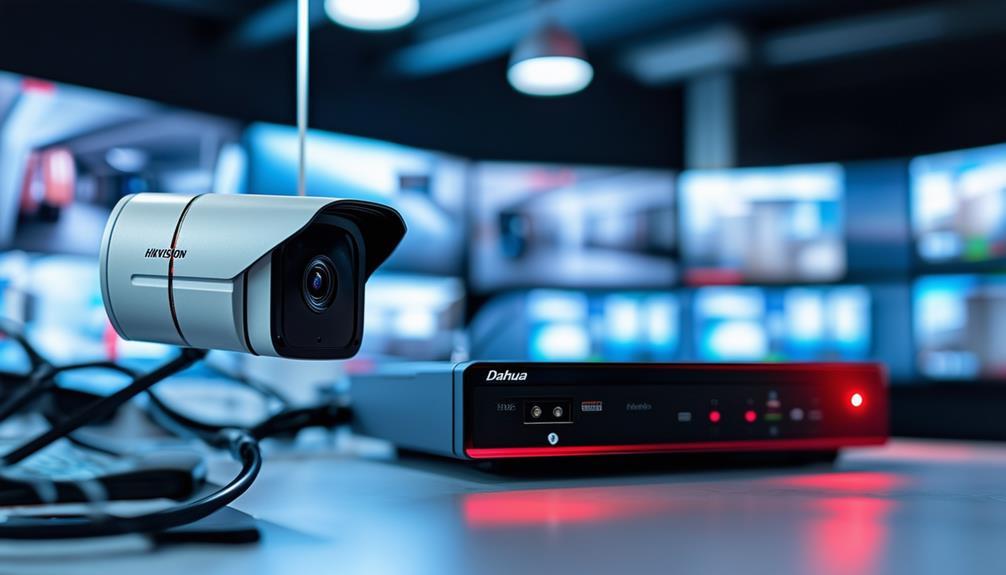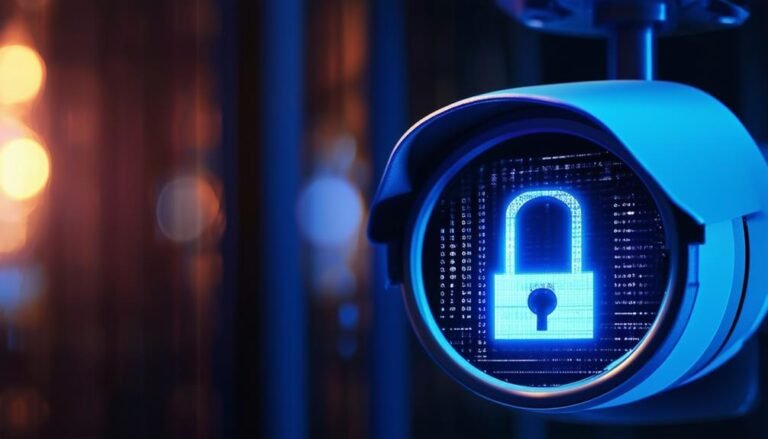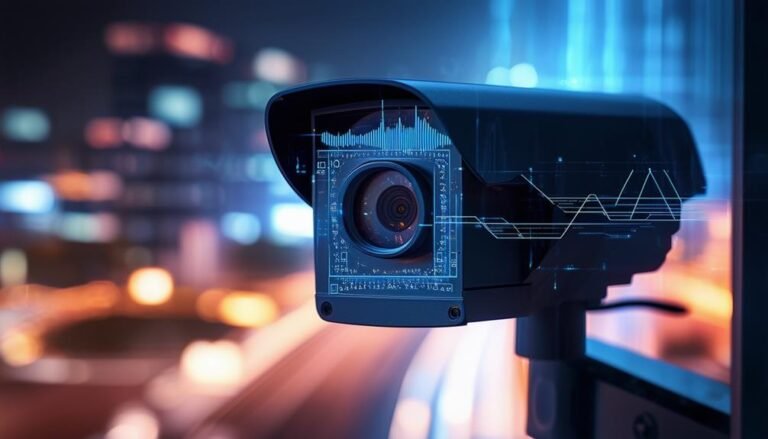To connect your Hikvision camera to a Dahua NVR, start by ensuring both devices are ONVIF compliant, as this enables cross-brand compatibility. Make sure your camera’s IP address matches the NVR’s subnet. Log into the camera’s web interface to configure the settings, using a static IP and setting the video encoding to H.264 or H.265. Next, access the Dahua NVR interface and add the Hikvision camera by inputting its IP address and login details. After saving the settings and rebooting the NVR, check for a live feed to confirm the connection is successful. There’s more helpful information ahead!
Understanding Compatibility
When you’re considering connecting a Hikvision camera to a Dahua NVR, it’s crucial to understand compatibility. You want your surveillance system to work smoothly, and knowing how these devices interact can save you a lot of headaches down the line. While both brands produce high-quality products, they’re built on different software platforms and protocols, which can complicate things.
Hikvision typically uses the HIKVISION protocol, while Dahua primarily employs the Dahua protocol. This difference in communication methods means that not all Hikvision cameras will directly connect to Dahua NVRs. However, if you’re craving the freedom to mix and match equipment, there’s still hope. Some Dahua NVRs support ONVIF, a universal protocol that allows devices from different manufacturers to communicate. If your Hikvision camera is ONVIF-compliant, you may have a pathway to connect them seamlessly.
Before diving in, make sure to check the specifications of both your camera and NVR. Look for ONVIF compatibility or specific model compatibility lists provided by Dahua. If you choose to go this route, you’ll enjoy a more flexible surveillance setup without being locked into a single brand. Remember, the goal is to create a system that meets your unique needs and gives you the freedom to choose the best tools for the job. So, take the time to understand compatibility; it’s the first step toward a successful installation and a more secure environment.
Required Tools and Equipment
To successfully connect a Hikvision camera to a Dahua NVR, you’ll need a few specific tools and pieces of equipment. Having the right gear makes the process smoother and allows you to enjoy the freedom of setting up your security system without unnecessary delays. Here’s a quick list of what you’ll need:
- Hikvision Camera: Confirm it’s compatible with the Dahua NVR. Check the specifications to avoid any compatibility issues.
- Dahua NVR: The heart of your security system. Make sure it’s configured to accept external cameras, including those from Hikvision.
- Ethernet Cables: Quality Ethernet cables are essential for a stable connection. Depending on your setup, you might need longer cables to connect the camera to the NVR.
- Power Supply: Verify your Hikvision camera has a reliable power source. Some cameras might require a separate power supply, while others could be powered via PoE (Power over Ethernet).
Having these tools and equipment at hand will prepare you for the setup process. You won’t have to scramble to find what you need, and you can focus on connecting your camera to the NVR seamlessly. Remember, the goal is to create a reliable surveillance system that offers peace of mind, so starting with the right tools will set you up for success. Now that you’re equipped, you can move on to the next steps in the connection process!
Camera Configuration Settings
Configuring your Hikvision camera is essential for establishing a successful connection with your Dahua NVR. To get started, you’ll need to access the camera’s web interface. Open your web browser and type in the camera’s IP address. You might need to log in using the default username and password, which are often “admin” for both. Once you’re in, change the password to something secure; you don’t want anyone messing with your settings.
Next, navigate to the network settings. Verify your camera is on the same subnet as your Dahua NVR. You might have to adjust the IP address, subnet mask, and gateway. A good practice is to use a static IP address for your camera, so it doesn’t change and disrupt your connection.
Now, go to the video settings. Depending on your needs, you can adjust the resolution, frame rate, and bit rate. Keep in mind that higher settings provide better quality but may require more bandwidth.
Also, check the encoding settings. Make sure the camera is set to H.264 or H.265, as these are compatible with your Dahua NVR.
NVR Setup Process
After setting up your Hikvision camera, the next step is to configure your Dahua NVR. This process can seem intimidating, but with a clear approach, you’ll be able to connect everything seamlessly. Here’s how to get started:
- Access the NVR Interface: Connect your Dahua NVR to a monitor and power it on. Use a mouse to navigate through the interface. You’ll typically log in using the default credentials unless you’ve changed them.
- Network Configuration: Go to the network settings. Make sure the NVR is on the same subnet as your Hikvision camera. This guarantees they can communicate without any hiccups. You might need to adjust the IP address of the NVR if they’re on different subnets.
- Add the Camera: Navigate to the “Camera” or “IP Camera” section in the NVR settings. Here, you’ll find an option to add a new camera. Input the Hikvision camera’s IP address, username, and password. Be sure to double-check these credentials to avoid errors.
- Save and Reboot: After entering the details, save your settings and reboot the NVR if prompted. This helps confirm that all configurations are applied correctly.
Testing the Connection
Once you’ve added your Hikvision camera to the Dahua NVR, it’s vital to test the connection to confirm everything’s working as it should. This step is fundamental for guaranteeing you have complete surveillance freedom. Start by traversing to your NVR’s main menu and look for the camera settings. Check the list of connected devices to see if your Hikvision camera appears.
Next, try accessing the live feed from your camera. If it streams correctly, you’re on the right path. If not, don’t worry—there are a few troubleshooting steps you can take. You may want to double-check the IP address configurations or verify that both devices are on the same network.
To give you a clearer picture of what to check, here’s a handy table:
| Step | Action |
|---|---|
| 1 | Check camera connection status |
| 2 | Access live feed |
| 3 | Verify IP settings |
| 4 | Restart NVR and camera |
| 5 | Consult user manuals if needed |
If you follow these steps and your connection is still shaky, consider updating firmware or resetting the camera. With a bit of patience, you’ll get everything running smoothly. Enjoy the peace of mind that comes with a reliable surveillance system, allowing you to monitor your space freely and effectively!
Frequently Asked Questions
Can I Mix Different Camera Brands on the Same NVR?
Imagine a vibrant garden where every flower tells a unique story. Just like that, you can mix different camera brands on the same NVR. However, it’s essential to guarantee they all speak the same language, like a harmonious choir. If they’re compatible, you’ll gain the freedom to tailor your security setup. So, don’t limit yourself; embrace the diversity, but remember to check compatibility to guarantee everything blooms beautifully together in your surveillance landscape.
What Should I Do if the Camera Is Not Detected?
If your camera isn’t detected, don’t sweat it. First, check the power supply and verify it’s properly connected. Then, inspect the network settings—make sure everything matches up. Sometimes, rebooting your NVR or the camera can solve the issue. Also, try using a different cable or port. If it’s still not working, consider updating the firmware. Remember, technology can be tricky, but taking these steps often leads to freedom from frustration!
Are There Specific Hikvision Models That Work Better With Dahua NVRS?
When it comes to compatibility, “the whole is greater than the sum of its parts.” Some Hikvision models, like the DS-2CD2 series, tend to work better with Dahua NVRs due to their shared protocols. However, don’t limit yourself; always check the specifications. You want freedom in your surveillance setup, so explore various options and configurations to find what suits your needs best. Experimenting might lead to the perfect synergy!
How Can I Reset My Hikvision Camera if Needed?
If you need to reset your Hikvision camera, you can easily do it by locating the reset button, usually found on the back or bottom of the device. Press and hold that button for about ten seconds until the camera reboots. This’ll restore factory settings, so make sure you’ve backed up any important configurations. After resetting, you can set it up again to suit your preferences and regain full control.
Is There a Warranty for Third-Party Camera Connections?
When it comes to third-party camera connections, warranties can vary based on the manufacturer and retailer. You might find that some brands offer limited warranties, while others don’t cover third-party integrations at all. It’s essential to check the specific warranty terms before making a purchase. Remember, staying informed about warranty details guarantees you’re prepared for any potential issues down the line, keeping your system running smoothly and hassle-free.



